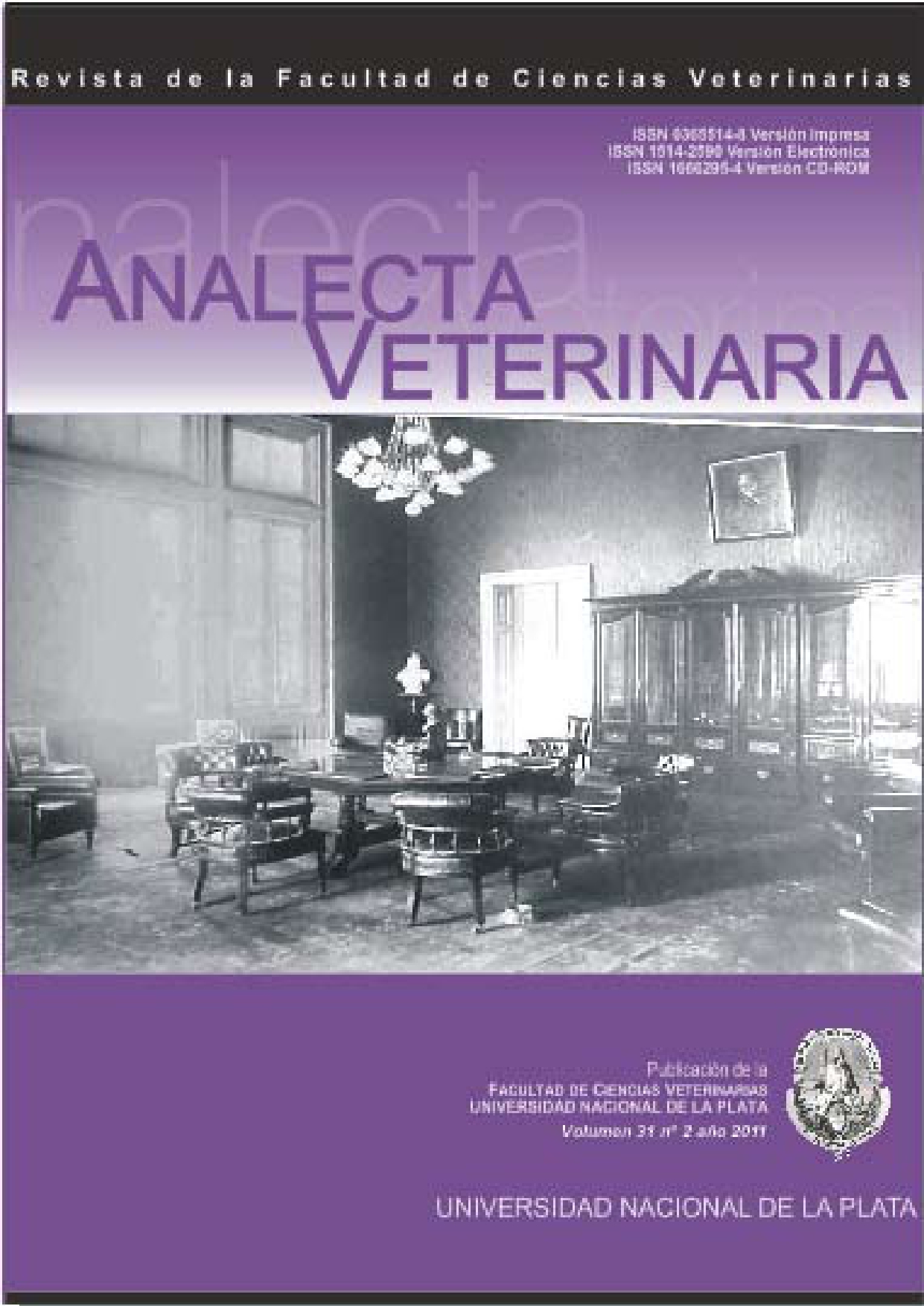Penetration of fosfomycin in HEP-2 cells and its interaction with deoxynivalenol
Keywords:
fosfomycin, deoxynivalenol, HEp-2 cells, pigsAbstract
Fosfomycin (FOS) is an antibiotic used in swine production for the treatment and prevention of resistant bacteria during the post weaning. The calcium salt form can be used in food or drinking water. Several studies showed the presence of this antibiotic in tissues and fluids such as lungs and bronchial secretions. The HEp-2 line cell is a model to study the penetration of systemically available FOS. Deoxynivalenol (DON) is a mycotoxin produced by Fusarium sp. that contaminates the raw materials and influences the performance of pigs negatively. The aim of this work was to study the penetration of FOS in cell culture lines and evaluate the interactive effect of DON on the penetration of the antibiotic in cell culture lines. The results showed that intracellular antibiotic concentrations in HEp-2 cells incubated with 130 ppm of calcium FOS oscillated between 0.4 and 1.12 mg/ml with a tmax of 8 h. When HEp-2 cells were incubated with FOS and DON, a significant variation was not observed on the cellular penetration of the antibiotic, as regard the Cmax (1.10 ppm) and tmax (12 h). It is concluded that the presence of the mycotoxin would not alter the cellular distribution of FOS in pigs.
Downloads
Metrics
References
Carro MD, Ranilla MJ. Los aditivos antibióticos promotores del crecimiento de los animales: situación actual y posibles alternativas. 2002. Disponible en: http://www.midiatecavipec.com.
Torres C, Zarazaga M. Antibióticos como promoto- res del crecimiento en animales. ¿Vamos por el buen camino? Gac Sanit 2002; 16 (2): 109-112.
Hendlin D, Stapley EO, Jackson M, Wallick H, Miller AK, Wolf FJ, et al. Phosphonomycin, a new antibiotic produced by strains of Streptomycetes. Sci 1969; 166 (901): 122-123.
Gattinger R, Mayer B, Heinz G, Guttmann C, Zeit- linger M, Joukhadar C, et al. Single– dose pharmaco kinetics of fosfomycin during continuos venovenous haemofiltration. J Antimicrob Chemother 2006; 58 (2): 367-371.
Sumano LH, Ocampo CL, Gutierrez OL. Intravenous and intramuscular pharmacokinetics of a single-daily dose of disodium–fosfomycin in cattle, administered for 3 days. J Vet Pharmacol Ther 2007; 30 (1): 49–54.
Gallego A, Rodriguez A, Mata JM. Fosfomycin: pharmacological studies. Drugs Today 1974; 10: 161-168.
Hernández S, García J, Muñoz J. Actividad in vitro de fosfomicina frente a enterobacterias de origen urinario productoras de betalactamasas de espectro extendido. Rev Esp Quimioter 2009; 22 (1): 25-29.
Gobernado M. Fosfomicina. Rev Esp Quimioter 2003; 16 (1): 15-40.
Escolar-Jurado M, Azanza-Perea JR, Sádaba-Díaz de Rada B, Honorato-Pérez J. Tetraciclinas, cloranfenicol y fosfomicina. Med 1998; 7 (76): 3524-3532.
Popovic M, Steinort D, Pillai S, Joukhadar C. Fosfomycin: an old, new friend?. Eur J Clin Microbiol Infect Dis 2010; 29:127–142.
Avantaggiato G, Havenaar R, Visconti A. Evaluation of the intestinal absorption of deoxynivalenol and nivalenol by an in vitro gastrointestinal model, and the binding efficacy of activated carbon and other adsorbent materials. Food Chem Toxicol 2004; 42 (5):817–824.
Lawlor P, Brendan-Lynch P. Mycotoxins in pig feeds 2: clinical aspects. Ir Vet J. 2001; 54 (4):172-176.
Desjardins AE. Fusarium mycotoxins: chemistry, genetics and biology. APS Press. St. Paul, Minnesota. 2006.
Eriksen GS, Pettersson H, Lindberg JE. Absorption, metabolism and excretion of 3-acetyl DON in pigs. Arch Anim Nutr 2003; 57 (5):335–345.
Dänicke S, Valenta H, Klobasa F, Döll S, Ganter M, Flachowsky G. Effects of graded levels of Fusarium toxin contaminated wheat in diets for fattening pigs on growth performance, nutrient digestibility, deoxyniva- lenol balance and clinical serum characteristics. Arch Anim Nutr 2004; 58:1–17.
Goyarts T, Dänicke S. Bioavailability of the Fusarium toxin deoxynivalenol (DON) from naturally contaminated wheat for the pig. Toxicol Lett 2006; 163 (3):171–182.
Soraci AL, Pérez DS, Martínez G, Dieguez SN, Tapia MO. Disodium-fosfomycin pharmacokinetics and bioavailability in post weaning piglets. Res Vet Sci 2010. Disponible en: http://linkinghub.elsevier.com/retrieve/pii/S003452881000247X.
Darouiche RO, Hamill RJ. Antibiotic penetration of an bactericidal activity within endothelial cells. Antimi- crob Agents Chemother 1994; 38(5):1059-1064.
Kiem S, Schentag JJ. Interpretation of antibiotic concentration ratios measured in epithelial lining fluid. Antimicrob Agents Chemother 2008; 52(1): 24-36.
Kahan FM, Kahan JS, Cassidy PJ, Kropp H. The mechanism of action of fosfomycin (phosphonomycin) Ann NY Acad Sc 1974; 235: 364-386.
Höger PH, Seger RA, Schaad UB, Hitzig WH. Chro- nic granulomatous disease: uptake and intracellular activity of fosfomycin in granulocytes. Pediatr Res 1985; 19 (1): 38-44.
Dänicke S, Goyarts T, Döll S, Grove N, Spolders M, Flachowsky G. Effects of the Fusarium toxin deoxynivalenol on tissue protein synthesis in pigs. Toxicol Lett 2006; 165 (3): 297–311.
Awad WA, Aschenbach JR, Setyabudi FMCS, Razzazi-Fazeli E, Böhm J, Zentek J. In vitro effects of Deoxynivalenol on small intestinal D -glucose uptake and absorption of Deoxynivalenol across the isolated jejunal epithelium of laying hens. Poult Sci 2007; 86: 15–20.
Downloads
Published
How to Cite
Issue
Section
License
Authors retain the copyright and assign to the journal the right of the first publication, with the with the terms of the Creative Commons attribution license. This type of license allows other people to download the work and share it, as long as credit is granted for the authorship, but does not allow them to be changed in any way or used them commercially.

Analecta Veterinaria by School of Veterinary Sciences, National University of La Plata is distributed under a Creative Commons Attribution-NonCommercial-NoDeriv 4.0 International License.

























